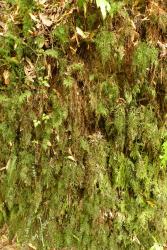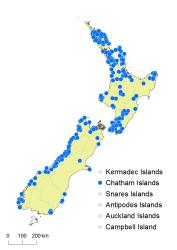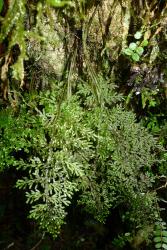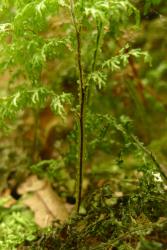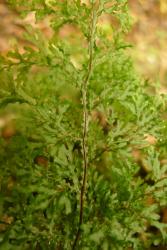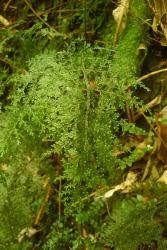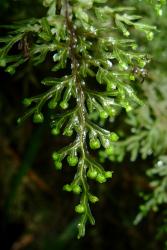- ≡ Hymenophyllum australe var. flexuosum (A.Cunn.) C.Chr., Index Filic. 361 (1905)
- ≡ Mecodium flexuosum (A.Cunn.) Copel., Philipp. J. Sci. 67: 24 (1938)
- = Hymenophyllum neozelandicum Gand., Bull. Soc. Bot. France 60: 28 (1913) – as H. neo-zelandicum
Terrestrial, rupestral or occasionally epiphytic ferns. Rhizomes long-creeping, 0.25–0.75 mm diameter; rhizome hairs pale brown, up to 1 mm long, clustered at bases of stipes, scattered elsewhere. Fronds 70–390 mm long. Stipes 20–125 mm long, reddish brown, with a broad wing almost to the base, glabrous or bearing a few scattered hairs especially proximally; stipe wings flexuous or rarely planate. Laminae 4–5-pinnatifid, or 3-pinnatifid in sterile fronds, narrowly ovate or ovate or elliptic, 45–295 mm long, 30–140 mm wide, green, membranous, glabrous or with very short scattered hairs on costae. Rachises with a broad wing throughout, reddish brown, glabrous or with a few scattered hairs; rachis wings flexuous or occasionally partly planate. Primary pinnae in 9–17 pairs, scarcely overlapping, with a flexuous wing throughout; distal portion of primary pinnae straight or slight incurved acroscopically; distal primary pinnae narrowly ovate or ovate or elliptic, adnate; proximal primary pinnae ovate to broadly ovate, adnate; the longest primary pinnae at or below the middle, 21–110 mm long, 12–45 mm wide. Secondary pinnae arising both acroscopically and basiscopically, scarcely overlapping, with a flexuous wing throughout, adnate; ovate or elliptic or obovate on distal primary pinnae, ovate or elliptic on proximal primary pinnae; the longest secondary pinnae 8–30 mm long, 4–13 mm wide. Ultimate lamina segments oblong, up to 5 mm long, 0.6–1.3 mm wide, sometimes flexuous; apices obtuse or truncate or occasionally emarginate; margins entire, lacking a distinct border; distal segments on primary pinnae divergent. Sori borne on short acroscopic and basiscopic segments throughout pinnae, solitary or sometimes paired, many on each primary pinna, adnate; indusia bivalvate; indusial flaps ovate or elliptic or oblong or broader than long, 1–1.5 mm long, apices obtuse or truncate, margins almost entire or irregularly dentate; receptacles included within indusial flaps.
Hymenophyllum flexuosum is distinguished from almost all other species of the genus in New Zealand by the broad flexuous wings on the stipes, rachises and primary pinnae. It is similar only to H. australe and H. pluviatile.
It can be distinguished from H. australe by its more divided laminae (4–5-pinnatifid cf. 2–4-pinnatifid), larger laminae (60–295 mm long, 40–140 mm wide, cf. 30–140 mm long, 10–60 mm wide), lamina shape (usually less than three times as long as broad cf. usually more than three times as long as broad) and flexuous rather than planate stipe and rachis wings. Hymenophyllum australe is further distinguished by growing only on rock in or beside streams, whereas H. flexuosum also grows epiphytically and on soil and rock away from streams.
Hymenophyllum flexuosum can be distinguished from H. pluviatile by its larger laminae (60–295 mm long, 40–140 mm wide, cf. 40–130 mm long, 20–70 mm wide), flexuous and broad stipe wings that extend almost to the base, rather than very narrow planate stipe wings usually confined to the distal half, and generally wider lamina segments.
North Island: Northland, Auckland, Volcanic Plateau, Gisborne, Taranaki, Southern North Island.
South Island: Western Nelson, Sounds-Nelson, Marlborough, Westland, Canterbury, Otago, Southland, Fiordland.
Chatham Islands.
Altitudinal range: 0–975 m.
Hymenophyllum flexuosum occurs in lowland forest throughout most of the North Island from the Maungataniwha Range south, extending locally into montane forest, especially in the higher parts of Northland. It grows from sea level to about 700 m in the Waima Forest and on Mt Taranaki, and to 975 m on Mt Pihanga near Taupō. In the South Island, it occurs from the Marlborough Sounds to north-west Nelson and along the west coast to Fiordland. There are also a few scattered records on the east coast, but it is absent from large areas of the interior, and from Stewart Island. It ranges from near sea level to 460 m on Mt George near Greymouth.
Occurs in podocarp, beech and broadleaved forest, and under mature kānuka, growing on the ground, in damp hollows, on damp rocks and banks, streamsides, under overhangs, on tree roots, on rotten logs and old tree stumps, and as a low trunk epiphyte. It has been recorded growing epiphytically on Cyathea dealbata, Dysoxylum spectabile, Fuchsia excorticata, Melicytus ramiflorus, Metrosideros sp., Rhopalostylis sapida and species of Nothofagaceae.
n = 36 (Brownlie 1961).
The names Hymenophyllum javanicum Spreng. and H. crispatum Hook. & Grev. have been misapplied to this species by some New Zealand authors.



